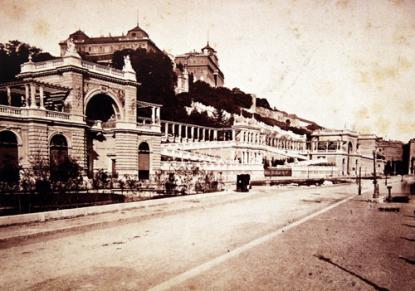2024. November 23. Saturday
New Budapest Gallery - Budapest
|
|
Address: 1056, Budapest Bálna-Budapest, Fővám tér 11-12.
Phone number: (1) 426-4714
E-mail: info@budapestgaleria.hu
Opening hours: Tue-Sun 10-18
|
The exhibition has closed for visitors.
2003.03.20. - 2003.04.21.
Museum tickets, service costs:
|
Ticket for adults
|
1000 HUF
|
/ capita
|
|
Ticket for students
|
500 HUF
|
/ capita
|
|
Ticket for pensioners
|
500 HUF
|
/ capita
|
Ybl Miklós designed the joined buildings in the Castle Garden in Buda closing the Danube Bank Side. The function of the buildings built in 1879 was to provide space for the studio of Stróbl Alajos opened in 1883 where exhibitions were held. The bazaar in the Garden provided space for the Historic Pictures of the National Museum for a short time, later for a collage and a painting school. In 1961-1984, a club operated there in the summers named Youth Park.

The statues in the Castle and most of those ornamenting the buildings of Budapest, the Maria Teresa statue, the Mathias memorial in Kolozsvár as well as the Arany János Statue in the Museum Garden the Anonymous Statue and the Bem Statue were made in these studios.
From the period of Stróbl Alajos hundreds of sculptors worked there in the next 120 years. Some of the artists worked there only for a few years until his studio was ready, Stróbl, Fadrusz, Ligeti Miklós and Pásztor János are a few to mention. Some like Berán Lajos, Füredi Richárd, Istók János worked there for decades. Huszár Imre and Vilt Tibor worked in the studio in the near past. It is true, the building served as a living quarter for many of the artists. However, it was mainly a meeting place for the colleagues. It was a spiritual medium where the idea of establishing a school never occurred. The artists could keep their autonomy in their codependence. Freethinking, openness and collegiality served to keep up the community even in the hardest times. Among the sculptors artists like Tersánszky Józsi Jenő, Berda József, Dávid Károly, Ferenczy Béni, Kodály Zoltán, Pilinszky János attended the studio.
Those who left the studio recently are the witnesses of the presence of the above mentioned: Garami László, Gáti Gábor, Gulyás Gyula, Kalmár János, Kampfl József, László Péter, ifj. Marosán László, Mátyássy László, Nagy Géza, Nyírő Gyula, ifj. Pál Mihály, Rátonyi József, Stössel Nánda, Szathmáry Gyöngyi, Szilágyi Bernadett, Szöllőssy Enikő, Tóth Júlia, Varga Imre és Vigh Tamás. The closure of the studios is a considerable loss for both the artist and non-professional society. The exhibition in the Budapest Gallery honors artists with one work from each of them. We also show the history of the bazaars.

The statues in the Castle and most of those ornamenting the buildings of Budapest, the Maria Teresa statue, the Mathias memorial in Kolozsvár as well as the Arany János Statue in the Museum Garden the Anonymous Statue and the Bem Statue were made in these studios.
From the period of Stróbl Alajos hundreds of sculptors worked there in the next 120 years. Some of the artists worked there only for a few years until his studio was ready, Stróbl, Fadrusz, Ligeti Miklós and Pásztor János are a few to mention. Some like Berán Lajos, Füredi Richárd, Istók János worked there for decades. Huszár Imre and Vilt Tibor worked in the studio in the near past. It is true, the building served as a living quarter for many of the artists. However, it was mainly a meeting place for the colleagues. It was a spiritual medium where the idea of establishing a school never occurred. The artists could keep their autonomy in their codependence. Freethinking, openness and collegiality served to keep up the community even in the hardest times. Among the sculptors artists like Tersánszky Józsi Jenő, Berda József, Dávid Károly, Ferenczy Béni, Kodály Zoltán, Pilinszky János attended the studio.
Those who left the studio recently are the witnesses of the presence of the above mentioned: Garami László, Gáti Gábor, Gulyás Gyula, Kalmár János, Kampfl József, László Péter, ifj. Marosán László, Mátyássy László, Nagy Géza, Nyírő Gyula, ifj. Pál Mihály, Rátonyi József, Stössel Nánda, Szathmáry Gyöngyi, Szilágyi Bernadett, Szöllőssy Enikő, Tóth Júlia, Varga Imre és Vigh Tamás. The closure of the studios is a considerable loss for both the artist and non-professional society. The exhibition in the Budapest Gallery honors artists with one work from each of them. We also show the history of the bazaars.
